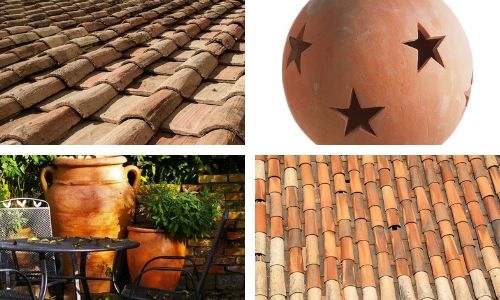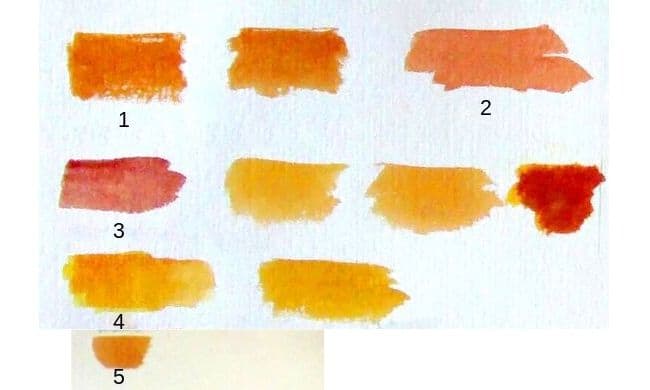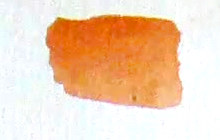Terracotta is a rich orange-red earth color. It is perfect for many different types of watercolor painting including landscapes.
There are lots of different ways you can mix terracotta in watercolors. What you use will depend on whether you want a light transparent color or a more opaque one. Also, it will depend on whether you want a bright strong color or a more muted one. Terracotta is simply red and orange combined. But how you combine these will make a difference. Below I have explored many color combinations to mix terracotta.
Learning to mix terracotta is a fun exercise. You may be surprised at what color combinations you can make into terracotta.
About Terracotta

Is Terracotta a Red or an Orange?
As you can see from the examples in the picture Terracotta is a beautiful rich earth color. Its color varies a lot depending on the type of terracotta and the light on it.

Terracotta is a color that is made up of mostly orange with red. Often old warn terracotta has a more muted faded appearance. While brightly lit terracotta is more orange than red. Highlties are almost white cream.
Many combinations of colors can make up terracotta.
I have taken this into account when creating the colors to work with creating the terracotta palette. (See below)
What Colors Make Terracotta?
While terracotta is an orange-red color. There are lots of different ways that you can mix different terracotta colors in watercolor depending on what hue and shade you want. Also depending on what colors you have available on your palette.
Color Combinations That Make Terracotta
Lots of color combinations make up various hues of terracotta. Some are more successful than others. See all the examples below. While there are many others these will give you a good headstart.
Note on Color Names: The names or colors supplied may vary from manufacturer to manufacturer. I have used mostly Winsor and Newton Cotman, with some Daler Rowney.
If you are using Daniel Smith you can try these instead if you don’t have them:
- Replace Lemon yellow with Hansa Yellow Light. (cool yellow)
- Cadmium Yellow with New Gamboge. (warm yellow)
- Permanent Rose with Quinacridone Rose. ( cool red)
- Cadmium red with Pyrrol Scarlet. (warm red)
- Intense Blue is Phtalo Blue.
- French Ultramarine is the same.
The results may vary as some of the colors are slightly different.
How to Mix Terracotta Watercolor
Below is a range of terracotta mixes. You can easily adapt them for your needs by adding or reducing the colors or strengths of the watercolor mix.
I have created many variations so that you have a large choice of colors to choose from depending on what you are painting and the lighting options. You can also dull these down or create shadows to increase the range.
Yellow and Red Terracotta Watercolor Mix

- Lemon Yellow + Cadmium Red (Scarlet Lake) + Ultramarine Blue (center one)
- Lemon Yellow and Alizarin Crimson
Lemon Yellow + Alizarin Crimson, Cadmium Yellow (Yellow Deep) + Cadmium Red (Scarlet Lake) + Ultramarine Blue
The colors in the two mixes above are from the main 6 colors recommended as a base palette. Most people will have these available to them. If not there are lots of other options below:

- Yellow Ochre + Alizarin Crimson
- Yellow Ochre + Permanent Rose
- Cadmium Yellow (Deep Yellow) + Alizarin Crimson
- Cadmium Yellow (Deep Yellow) + Light Red
- Deep Yellow (Cad Yellow Deep) + Raw Sienna + Cadmium Red
Yellow + Brown Colors Make Great Terracotta

- Cadmium Yellow (Deep Yellow) +Burnt Sienna (is a yellow-brown)
- Cadmium Yellow (Deep Yellow) +Burnt Sienna + Umber
- Lemon Yellow + Burnt Sienna
Orange Terracotta Watercolor Mixes
These mixes are using a pre-mixed orange.

- Orange + Burnt Sienna
- Orange + Burnt Sienna + Crimson Lake (Cadmium Red)
- Orange + Light Red
- Orange + Crimson Lake (Cadmium Red)
- Orange + Black
Light Brown & Red

Raw Sienna + Cadmium Red + Cadmium Yellow (Yellow Deep)
Red Mixes

Note: these look more brown on the original than they do here.
- Cadmium Red + Mauve (413 Winsor & Newton)
This makes a lovely deep strong terracotta. If you want to lighten it up a bit you can use cadmium yellow.
This could also work with violet. - Cadmium Red + Mauve (413 Winsor & Newton) +Cad Yellow
- Cadmium Red +Viridian Green
This works well but I find that variations are limited before you get brown. You can add cadmium yellow for further variations. - Cadmium Red Pale Hue + Black
Burnt Sienna Going Solo

Burnt sienna works quite well on its own as a terracotta. It is a reddish-brown. It is an earth pigment that has manganese oxide and iron oxide. Keep in mind that it is transparent.
If you want more opacity, use orange and light red as they make a lovely burnt sienna color. Light red is opaque and orange transparent so you will get a semi-transparent finish.
More Color Variations
The list above is only an example of what can be achieved. If you want to create variations you can do the following
- Simply add more water for more colors.
- Use different strengths of the colors shown.
- Add complementaries to dull down or mute the color.
- Try experimenting with your paints. You may have different ones to the ones listed here that will work.
General Guide To Mixing Terracotta
- When you mix terracotta start with the lighter color first. Ie Yellow, Cadmium yellow, orange, etc. Always the first color listed in the list below.
- Use a large amount of the lighter color.
- Slowly add only very small amounts of the 2nd color.
- Once you get the desired color or near to it if it is a 3-color mix, only then add the 3rd color. The 3rd color is designed to “dull” down the mix very slightly. Only add minuscule amounts of the 3rd color. These will be the complementary colors on the color wheel e.g. blue.
Materials
- Watercolor brush
- Watercolor paper 300gsm or above weight or
- Watercolor sketch pad. They are often a lighter weight mine is 230gsm
- 2 x Water in a jam jar or other container
- Tissues for wiping
- A variety of combinations of the paints are listed above.